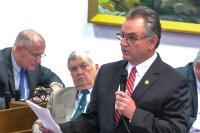New bypass alone can’t fix N.C. 107 traffic
A fix for impending traffic congestion on N.C. 107 in Sylva doesn’t lie solely with a new bypass but will require a redesign of the commercial artery itself, according to the latest traffic projections by the Department of Transportation.
Two sides have emerged in the long-standing debate over whether to build a new highway around Sylva. One camp wants to build a bypass allowing commuters to skirt the commercial mire of N.C. 107. The other wants to redesign N.C. 107 so traffic flows better.
The answer could be both, according to recent DOT traffic projections. The Jackson County Transportation Task Force held a public meeting last week to gather input on both ideas, although participation was very low.
A new bypass would not divert enough cars from the commercial hotbed on N.C. 107 to solve future traffic woes, according to the traffic projections. Back-ups on the stretch largely stem from people coming and going from places along the congested stretch itself, according to Pam Cook, a DOT transportation planner working on a master transportation plan for Jackson County.
Opponents of a new bypass, known as the Southern Loop, have long insisted that it wouldn’t solve congestion. Joel Setzer, head of the DOT for the 10 western counties, said he, too, always knew that a bypass wouldn’t solve all the problems. It’s one reason Setzer called for a separate congestion management study now underway by DOT experts in Raleigh.
Whether the result will be a full-fledged redesign of N.C. 107 or simply tinkering with the timing of stoplights won’t be known for at least a year, likely much longer. The congestion management study is still in its early stages — so early in fact there are no numbers on how much a redesign will help.
Related Items
Theoretically, a host of congestion management techniques could be implemented, each one ratcheting up the traffic flow and reducing back-ups. Although the DOT engineers haven’t run the specific traffic models to see how much each technique would help, they’ve looked at it enough to say that whatever it is, it won’t be enough.
“Will it be enough to handle all the traffic to make it function well?” asked Cook. “Probably not. That is something we have to determine.”
Why not wait before making a decision in that case, asked Susan Leveille, a member of the Jackson County Smart Roads Alliance.
“I am still a bit confused why we can’t look at congestion management on 107 before we spend hundreds of millions developing a bypass,” said Leveille. “You need to look at the small things you can do. You don’t bulldoze down your house because you need another bathroom.”
Decision pending
The Jackson County Transportation Task Force will be asked to endorse a countywide transportation master plan in the coming months. It not only will address N.C. 107, but span the entire county — from congestion in Cashiers to Main Street in Sylva to the campus of WCU.
The task force is being pushed to put its stamp of approval on a long-range plan — which at the moment calls for the construction of the bypass — before the traffic models for 107 fixes are finished.
Jeanette Evans, a member of Smart Roads and opponent of the by-pass, questioned the wisdom of endorsing a bypass until the task force has a better handle on how much fixes along N.C. 107 will help.
“I would like to be able to play with 107 in some respects to see how it works if we do this or that,” Evans said at a public meeting last week.
Ryan Sherby, a transportation coordinator who serves as a liaison between mountain communities and the DOT, questioned whether that was the task force’s job.
“The task force is a vision body, not an engineer body,” Sherby said.
“If you don’t know what the options are or the consequences of this or that action, how can you vision?” countered Leveille. “It seems to me like we are being asked to make a decision without all the information.”
Cook reiterated that congestion management, while needed, would fall short.
“My opinion at this point is that I don’t think there will be enough with congestion management,” Cook said.
Leveille and Evans said they did not understand why they are being rushed into approving a plan by July. The task force spent 18 months corralling and sifting through population and growth data. It only began the nitty-gritty work of analyzing the different road options two months ago. July is too soon to sign off on a master plan, they said, especially since it addresses everything from widening Main Street on the outskirts of Sylva to widening U.S. 64 in the middle of Cashiers.
“I don’t see how we can come up with a comprehensive plan in a matter of three or four months,” Leveille said.
Initially, the July deadline would allow the DOT to incorporate the task force recommendations into its annual planning process, Sherby said. It could be pushed back a couple months, however, Sherby said.
All the options are predicated on traffic models for 2035, when congestion on some roads will surpass what the DOT considers acceptable. But that model has been called into question.
“Are we planning for 2035 as we have lived in the past?” questioned Myrtle Schrader, who attended the meeting last week. “I don’t hear anything about the future of transportation. We need to look at what our lifestyle can and should be here in the mountains.”
Dr. Cecil Groves, president of Southwestern Community College, said that it is fair and accurate to assume there will be more cars on the road by 2035.
“What we know is if we don’t do anything it only gets significantly worse and more difficult to correct. The population here is going to grow. So we have to make an educated guess the best we can,” Groves said.
Groves advocated for more thought-out land-use planning that would influence commercial growth, rather than figure out how to accommodate it once it has cropped up.
Another question involved the DOT’s definition of congestion. Is the congestion a brief spike during commuter hours, or is it sustained and chronic? Setzer said the congestion was more than a momentary spike, but wasn’t all-day congestion either.
Compromise afoot?
News that the DOT is considering a redesign of N.C. 107 coupled with a bypass — rather than either-or — could signal the beginning of a compromise.
The bypass, formerly known as the Southern Loop, was initially billed as a major freeway through southern Jackson County, looping from U.S. 23-74 north of Sylva to U.S. 441 south of Dillsboro. Somewhere in between it would cross N.C. 107 with a major interchange.
In response to public opposition, the DOT dropped half of the Southern Loop — the part extending to U.S. 441 south of Dillsboro.
The DOT is still seriously contemplating the other half, but the language describing the road has been toned down. Instead of the once-touted four-lane freeway, the DOT shifted gears in the past year to consider a two-lane road instead.
That two-lane road would claim enough right of way to accommodate four lanes one day, said Joel Setzer, head of the DOT for the 10 western counties. It would still be designed for a speed of 55 miles per hour. It would still operate like a freeway in the sense of limited access from driveways or intersecting roads. And where it joined N.C. 107, it would likely have an interchange rather than an intersection with a stoplight, Setzer said. But the two-lane concept is scaled down nonetheless.









